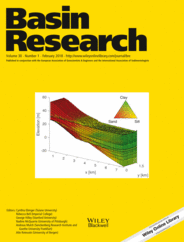
Full text loading...
 , Shugen Liu1, Lei Jiang1, Gaoping Zhao1, Rui Huang1, Zhiwu Li1, Jinxi Li1, Luba Jansa3
, Shugen Liu1, Lei Jiang1, Gaoping Zhao1, Rui Huang1, Zhiwu Li1, Jinxi Li1, Luba Jansa3
The Xichang Basin in southeastern Tibet provides crucial information about formation and tectonic processes affecting the eastern Tibetan Plateau. To determine when and how the uplift developed, we conducted detailed studies of structures and obtained thermochronology data from the Xichang Basin and its periphery. The Xichang Basin is characterized by gentle deformation of the strata, segmented by an E‐vergent boundary thrust fault. Two stages of deformation, strike‐slip followed by an E‐W oriented shortening resulted in oblique shortening between the southeastern Tibetan Plateau and the Sichuan Basin. New apatite fission‐track data interpreted together with (U‐Th)/He data confirm a simple burial/heating and exhumation/cooling history across the Xichang Basin and its periphery. Subsidence and burial of the Xichang Basin peaked between 80–30 Ma, followed by mountain building with a protracted cooling starting at around 40–20 Ma, with rates of ca. 2.0–8.0 °C Myr−1 (i.e. 0.1–0.3 mm year−1). Our data indicate that the Xichang Basin has experienced ca. 2.5–5 km of exhumation, much more intensive than the ca. 1–2 km of exhumation inferred for the southwestern Sichuan Basin. Restored balanced cross‐sections of post‐Late‐Triassic strata along a ca. 250 km traverse indicate ca. 10–20% east‐west shortening strain (i.e. ca. 20–30 km) at the southeastern Tibetan Plateau during Cenozoic time. Study of crustal thickening and erosion supports a tectonic shortening mechanism to account for the uplift of the Xichang Basin on the southeastern Tibetan Plateau.

Article metrics loading...

Full text loading...
References


Data & Media loading...

